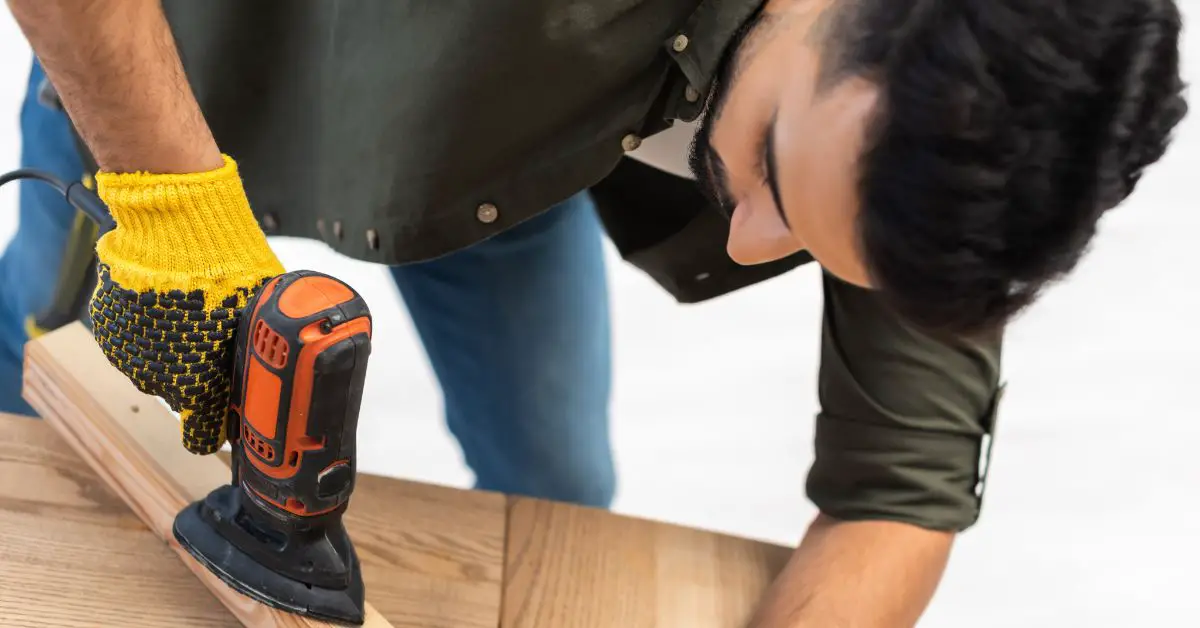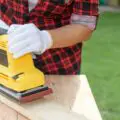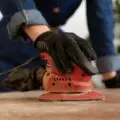Sander
Best Sander for Furniture Restoration
Best Sander for Furniture Restoration
The thing about sanders is you have to know when to use them. I find it easier to choose the best sander for furniture restoration when I categorize them according to their sanding capabilities:
Light duty – Sandpaper and sanding gloves
Medium duty – Orbital and mouse sanders
Heavy duty – Belt sanders
When refinishing furniture, I rarely go beyond an orbital sander. Using different grits, it’s quite easy to sand down any surface to the desired texture. Sandpaper and sanding gloves come in handy when smoothing corners, so they’re pretty helpful for woodworking projects too.
Regardless, you’re not here to learn about sandpaper, so I’ll tell you the one thing I wish I’d known before buying my first sander: they are not always easy to control.
In this article, I’ll explain why you need to be mindful of the type of sander you need, plus a few other factors to keep in mind when shopping around.
Types of Sanders
Belt Sanders
Belt sanders may be overkill for many furniture restoration projects, but they serve a purpose. If you’re refinishing large tables and dressers with thick coats of paint or varnish, you’ll appreciate the mountains of power they offer.
However, you better hang on tight if you choose this sander. It has quite a kick and will get away from you faster than you can react if you don’t have a firm grip on it.
Most newbies (me included) will struggle to control a belt sander if they’re not used to using it. Though these are the most powerful types of sanders available, they’re also the hardest to control and, as a result, often left to professionals.
Orbital Sanders
Probably the most common type of sander is the random orbital sander. This type of sander features a sanding pad (usually square or circular) that vibrates rapidly in tiny orbits. It can be corded or cordless and is traditionally reserved for rough sanding jobs for reasons we’ll discuss shortly.
Orbital sanders are far easier to control, at least compared to orbital sanders. They deliver less power, so they’re better suited for medium and small sanding jobs.
I wouldn’t use this to finish any surface because of the orbital motion. In my opinion, its orbital motion goes against the wood grain far too much to create a consistent finish. These scuffs become more visible after staining because it settles into the grooves.
That’s why I always have two types of sanders ready.
Mouse Sanders
The other type of sander I use religiously is the mouse sander. It’s roughly the same size as an orbital sander, but its shape lends it to slightly different applications.
On a mouse sander, your sandpaper goes on a triangular head that vibrates to create the sanding motion. This configuration is far more convenient for sanding corners and other tight spots.
Sandpaper and Sanding Gloves
I use sandpaper and sanding gloves to get to small patches that my motorized sanders cannot access. They contribute a great deal to the quality of my finish. Small projects demand the use of these types of sanders since they’re more adept at sanding tiny crevices.
Constructing a Sanding Toolkit- What You Need
1. WEN 6321 Belt Sander
This 7-amp sander has a single-speed motor and a 3 x 21-inch belt that empties in a dust bag attached to the rear.
It weighs just over six pounds, so it’s quite agile for its size. The 7-amp motor spins the belt at 13 feet per second, making the sander capable of grinding down thick layers of paint and varnish.
This model has a lock-in feature, which keeps the motor running even when the trigger isn’t held down. It also has a detachable dust bag.
This one’s a perfect fit for your first belt sander — affordable yet powerful enough for heavy-duty furniture restoration.
2. BLACK + DECKER Random Orbital Sander
With close to 9,500 five-star reviews, this random orbital sander from BLACK + DECKER is one of the best in the business.
Its 5-inch sanding pad is powered by a modest 2-amp motor and mounted underneath a comfortable grip handle. The random orbital movement eliminates swirls, but you can still catch a few scuffs if you’re not careful.
Weighing just over 3.5 pounds, it’s not easy to make mistakes with this compact sander. It’s reasonably easy to handle and has a decent amount of power to handle sanding jobs of various complexity.
Small as it is, it is equipped with a dust collection bag, which is pretty much a necessity if you’re trying to avoid wood dust for health reasons.
3. BLACK + DECKER Mouse Sander
My go-to for sanding in tight spaces is this BLACK + DECKER mouse sander, a compact sander with a good dust collection canister and a very comfortable 3-position grip.
The 1.2-amp motor that powers it is capable of up to 16,000 orbits per minute. Its built-in dust collection canister is equipped with micro-filtration technology, making it better at keeping hazardous sawdust away from your lungs.
This model is handy for sanding narrow and constricted surfaces because it comes with a convenient detail finger attachment, an accessory that extends its reach into tight spaces even further.
That’s really useful, especially since the sander is already tailored for tight spaces. If you factor in this sander’s ability to create smooth finishes, it’s easy to see why I prefer to use it almost exclusively to finish my refurbished furniture.
The compact sander weighs just under 2.6 pounds, and since it’s corded, it can handle prolonged use reasonably well.
4. Norton Sanding Gloves
Sanding gloves aren’t hard to buy, but I find these to be slightly above average. They’re comfortable and easy to use, plus they’re built fairly durably.
They are one-size-fits-all, have a ventilated side to keep the sweats at bay, and come with 80 compatible sheets of sandpaper for the reusable glove. Even the Velcro course sponge that holds the sandpaper can be replaced if worn out.
Best of all, it’s dirt cheap, so you can afford to stash away a few of them for emergencies.
Why You Should Trust Us
At Woodworking Tool Guide, we know one size doesn't fit all! We cater to every woodworker, from beginner to pro, with insights and recommendations tailored to your skill level, project needs, and budget. We take the guesswork out of choosing the right tools, whether you're tackling your first crafting a masterpiece for the ages. So grab your chisel, join our community, and let's build something amazing together!
Woodworking Tool Guide wasn't just born, it sprouted from a seed of passion for the craft. What started as a joyful exploration blossomed into a trusted online haven for fellow enthusiasts like you. We pour our love into meticulously chosen review selections, meticulous hands-on testing, and lab-backed insights, all to empower you with reliable, comprehensive information you can build on. So, grab your tools, trust our guidance, and let's build something beautiful together!
Passion-Driven Expertise
Our journey started with a shared love for woodworking. The team behind the Woodworking Tool Guide is comprised of individuals who are not just writers but passionate woodworkers themselves. This shared enthusiasm ensures that our content is crafted with a deep understanding of the craft and an authentic appreciation for quality tools.
Top Tool Guides Online
Woodworking Tool Guide has rapidly ascended to become one of the premier online destinations for tool guidance. Our commitment to excellence and the accuracy of our information has positioned us as a reliable source for both beginners and seasoned woodworkers seeking trustworthy advice on the best tools for their projects.
User-Centric Approach
Our content caters to every woodworker, from rookies just starting out to seasoned pros tackling intricate projects. We tailor our insights and recommendations to your skill level, project needs, and budget, ensuring you find the perfect tools to match your unique woodworking journey. So step into your workshop, grab your tool belt, and let Woodworking Tool Guide be your trusted companion as you craft your masterpieces.
Continuous Support and Innovation
Woodworking is an ever-evolving craft, and so is our commitment to supporting you. We are dedicated to bringing you the latest information on woodworking tools, techniques, and trends. Our team is actively working to expand our content and bring you more valuable insights, ensuring that you stay well-informed in your woodworking adventure.
Hands-On Experience
Ditch the endless research rabbit hole! At Woodworking Tool Guide, we believe in actionable advice, not armchair analysis. We get our hands dirty, putting every tool through its paces in real-world woodworking scenarios. Whether it's the precision of a table saw, the versatility of a router, or the tactile satisfaction of a handplane, we test for performance, durability, and user-friendliness. No more sifting through dry specs – we deliver practical insights you can trust to transform your woodworking dreams into reality.
Woodworking Tool Guide isn't just a review site, it's your trusted companion on the sawdust-filled path to woodworking mastery. Our expert team, led by veteran David Jones, meticulously tests and explains tools in terms you understand. We cut through the jargon, bias, and confusion with real-world insights and honest evaluations. Join our passionate community, where decades of experience, cutting-edge knowledge, and shared love for the craft come together to guide you every step of the way. So grab your chisel, buckle up, and let's embark on this exciting woodworking adventure, together!









